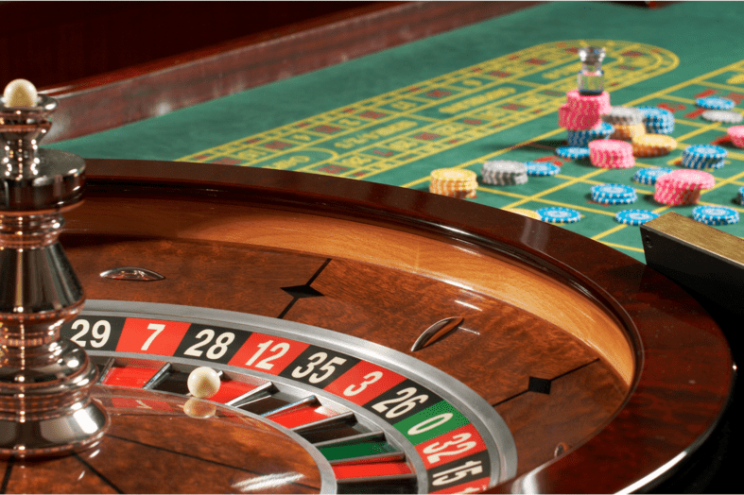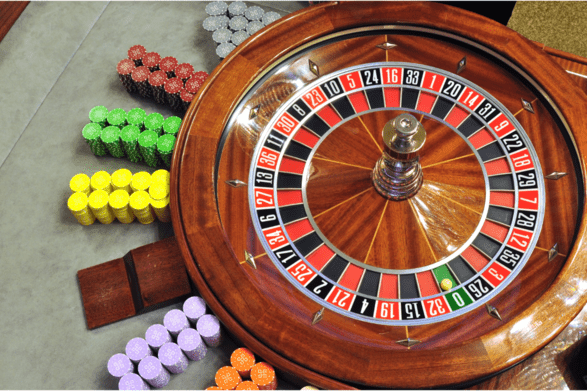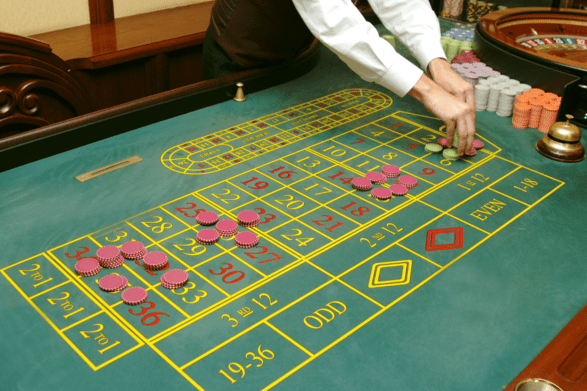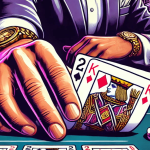Best Roulette Strategies
Roulette is one of the most popular gambling games in the world. In almost every casino you can find people sitting at the roulette table, placing their bets, carefully and silently following the roulette ball with their eyes to see which number comes out next. Automatic roulette machines and online apps are becoming prevalent in ... Best Roulette Strategies
StrategyRoulette is one of the most popular gambling games in the world. In almost every casino you can find people sitting at the roulette table, placing their bets, carefully and silently following the roulette ball with their eyes to see which number comes out next.
Automatic roulette machines and online apps are becoming prevalent in the last few decades, although at some casinos you can still find old-school roulette wheels where a croupier spins the ball manually. Roulette has been played for centuries, and it’s become one of the favorite games for gamblers worldwide.
Before we get to analyzing the best roulette strategies, let’s briefly explain the rules and fundamentals of the game for those who are not familiar with it.

The game of roulette
The main idea behind the game of roulette is pretty simple. At the center of the game, there’s a wheel with 37 fields (18 black ones and 18 red ones marked with numbers 1-36, plus one green field marked with 0) that spins in one direction, and the ball that spins in the other. Before the croupier or the machine spin the ball, players bet on fields where the ball might end up.
There are many different bets the players can place. You can place your money on a certain number or multiple numbers, which is the simplest way to play roulette. However, you can bet on odd or even numbers, high or low numbers, black or red fields, groups of numbers, columns, or even numbers on a certain part of the wheel.
The payouts are pre-determined and quite simple, and the fewer numbers you bet on, the more money you can earn in proportion to the size of your bet. Once the ball falls into one of the fields, winners collect their money and the new round starts.
Best roulette betting strategies
Now, it’s crucial to emphasize that the game of roulette is completely random. That is, it’s impossible to predict the next number based on previous numbers or sequences. It’s not rare to hear players convinced that they know which numbers often come out in groups or that they’ve learned how the machine’s algorithm works.
Nevertheless, whoever claims this is either a fraud or simply highly delusional. Of course, there are some casinos that use illegal methods to generate winning numbers in order to make more money, but this is extremely uncommon. The entire process is absolutely random and that’s the whole point of the game.
So what sort of a strategy can you have in a random casino game? Well, you can apply different betting tactics and patterns in order to maximize your earnings.
You’ll hear some players claiming they know tricks that can help you beat the casino every time, but that’s also not true. There’s no game plan that will guarantee that you’ll leave the casino or a gambling app with more money than you invested. But there are, however, some clever strategies that can help you minimize risk or increase your chances of making a profit in the long run.
So let’s check some of the most widespread and most successful roulette betting strategies.

Martingale
Martingale is probably the most famous roulette strategy. It’s actually a method of investing commonly used in gambling as well as outside of it. We can see players using it in card games, roulette, and even sports betting.
This system is based on the idea of negative progression. This means that if you lose, you add more money on your next bet so that when you win, you compensate for that loss. And you do it repeatedly until you manage to win.
So a martingale is a type of negative progression where you play on even money bets (which means that you win the exact amount of money that you bet) and double your investment every time you lose. In roulette, you’d usually put your money on the same field every time – for instance, on odd numbers. But in theory, it’s really all the same if you’re going to stick to the same field or switch up – roulette, as well as any type of game driven by random patterns, has no memory.
How does martingale works in practice? Say you put $10 on odd numbers. If you win, you take the money and bet $10 again. If you lose, you bet $20. If you lose again, you bet $40, then $80, and so on. When you finally win, your next bet is $10 again and you start over.
The dangers of martingale
A good thing about martingale is that you’ll almost always end up with some profit, unless you’re really unlucky and get into a long streak of losses. But the amount of money you need to bet to proceed with the martingale strategy can quickly become massive. With a $10 starting bet, after 10 consecutive losses you’ll need more than $10000 to cover your expenses and continue playing.
But you can’t lose 10 times in a row, right? Oh yes, you can. To make things worse, casinos usually put a cap on maximum bets, so even if you’d have huge amounts of cash to spend, the casino won’t let you raise your investments anymore and you’ll just end up losing big money.
Furthermore, winnings from martingale are usually unimpressive, especially with low starting bets. Let’s try to calculate what you’ll get after losing 6 times and then finally winning.
- Investment: $10 + $20 + $40 + $80 + $160 + $320 + $640 = $1270
- Payout: $640 X 2 = 1280
So you’re going through all this risk for $10! And you don’t have to calculate really, your winnings will always equal your initial bet, which is usually just not worth it. Especially given that your initial bet should be as small as possible, so that you’ll have more attempts before hitting the cap set by the casino.
So, by using martingale you’re basically risking a lot of money for a small potential profit. Most of the times you’ll get that profit, but it’s enough to have one bad streak and to go practically bankrupt. However, there are ways to increase the potential profit or lower the risk.
For instance, you can set your own limits and decide in advance to give up raising bets after 3, 4, or 5 losses. But that way you won’t be leveraging the biggest strength of martingale – the low probability of huge bad streaks, and you’ll lose more often. But you won’t go bankrupt though.
Or you could avoid playing even money bets and go for the riskier ones where you’ll get more money if you win. But this is even riskier as you’re again lowering your chances to win and increasing the probability of losing 10, 12, or 15 times in a row. So however you choose to play martingale, be very careful and reasonable or you can end up in real trouble.
Reverse martingale
Apart from negative progression, there are positive progression strategies as well. You guessed it – it means that you increase your bets after you win, and bet the amount equal to the initial bet if you lose. Reverse martingale falls into this category.
This is a much safer strategy in terms of not risking losing a ton of cash at any point. It’s much more financially responsible as you’re not playing with money you hope to win in the future like in classic martingale.
However, without setting the limits it’s obviously completely ineffective. If you double your bet every time you win, you will win a lot of money when you’re on a hot streak, but this streak has to stop sometime.
The usual way to limit yourself is to go back to your initial bet after three consecutive wins. So if you start with $10 and win, next time you bet $20, and if you win again, you bet $40. If you’re lucky for the third time, don’t push it anymore and next time bet only $10 again. This is a popular special case of reverse martingale and it’s called the Paroli system. Let’s see how much money you’ve earned in the process.
- Investment: $10 + $20 + $40 = $70
- Payout: $20 + $40 + $80 = $140
So you’re up $70, or 700% of your first bet. And you don’t risk too much really. Nevertheless, in order for this tactic to work, you need three hits in a row, which is reasonable but can be more difficult than it seems sometimes.

D’Alembert
This is another negative progression-type of strategy, but a lot safer and less hazardous. Here, you don’t double your bet every time you lose, but increase it by a pre-determined unit. If you win, you don’t go back to the initial bet, but you lower your bet by the same unit. D’alembert, as well as martingale, requires playing even money bets.
Let’s assume you start with $10 again, with $1 as the unit you use to raise or lower the bets. If you win, next time you bet $9. If you then lose three times in a row, you bet $10, $11, and $12 respectively. Then if you win again, you bet $11 and so on.
Investment: $10 + $9 + $10 + $11 + $12 = $52
Payout: $20 + 0 + 0 + 0 + $24 = $44
In this sequence, after winning twice and losing three times, you’re down $8, which is in a sound proportion with the number of hits and misses. In general, if you win more than you lose, you’ll earn some money, and if you lose more than you win, you’ll lose a reasonable amount of money. A slight increase in bets every time you lose helps you compensate for the losses without risking huge amounts of cash.
Admittedly, chances for huge profits are slim, unless you’re on a really hot streak, but that’s just how it is in roulette – there’s no easy money. However, this is a reasonable and effective tactic that ensures long-term balance and stability.
Contra D’Alembert
Contra D’Alembert tactic uses the D’Alembert betting pattern, but in reverse. You simply raise your bet if you win and lower it if you lose. If you’re increasing and decreasing your bets by really small units, there’s not much difference between the two D’Alembert systems.
Contra D’Alembert is an even safer strategy than the original D’Alembert as you raise your investments with the money you’ve already won, and you’re not counting on the money you’re supposed to win in the future. Both D’Alembert tactics are great for patient players who like to sit at roulette tables for extended periods of time and enjoy the long game.
Labouchere
Like the majority of the most popular roulette strategies, Labouchere also has progression and even money bets at its heart, but its mechanism is a little bit more complex.
Labouchere strategy starts with setting your target winnings. Let’s say it’s $50. Then you divide $50 into a certain number of separate bets, for instance $8, $5, $10, $7, $9, $12. Now you take the outermost bets and you start by betting their sum. In this case, it’s $8 + $12, so you start the cycle by betting $20.
If you win, you take these two numbers out, and take the sum of the next outermost numbers, in this case, $5 and $9, and bet $14. If you win again, you cross out $5 and $9, and combine the two remaining numbers, $10 and $7, to invest $17. If you’re lucky again, the cycle is over and you’ve won $50. So far it’s quite simple, but it’s always simple when you’re winning.
The complicated part comes if you start losing. So if you bet those initial $20 and lose, you add the failed bet to the list as the rightmost number.
The list looks like this now: 8, 5, 10, 7, 9, 12, 20
Now you bet $20 + $8, or $28 in total. If you lose again, you add this new bet as the rightmost number.
The updated list looks like this: 8, 5, 10, 7, 8, 12, 20, 28
So next time you bet $36. Once you win, you cross the leftmost and rightmost numbers out, go for the next two outermost numbers (5 and 20), and continue betting in the same fashion until you’ve crossed them all out.
At the end of a Labouchere cycle, you’ll always end up winning the target amount of money. You just need to get more wins than losses over a certain period of betting. By using shorter sequences and larger bets you’ll need fewer wins, but if you wish to divide the target sum into more small bets, you’re going to need a better win-loss proportion.
Bad streaks won’t put you in too much trouble as your bets will be increasing somewhat moderately. However, just like with any negative progression, it might take some time until you win enough times to reach your goal, and the amount of money you’ll have to spend in the process may get a bit out of control.

Reverse Labouchere
As you’d suppose, the Labouchere strategy also has its reverse version. But in reverse Labouchere, the target you set at the beginning is not how much you want to win, but how much you’re prepared to lose.
So every time you lose, the sequence gets smaller, and every time you win, you add larger numbers to the sequence and place larger bets. It’s crucial that you set a reasonable limit, just like in reverse martingale. You can’t go winning forever, and if you want to go home with more money than what you had at the beginning, you have to set a cap on the number of wins or the amount of cash you’d like to win.
Fibonacci strategy
The core of the Fibonacci strategy is the well-known Fibonacci sequence, which has broad applications in arts, maths, natural sciences, and many other areas. There are multiple versions of this strategy, but they all include a betting pattern that follows this series.
In the Fibonacci series, every number is the sum of the two previous numbers. So the first 10 numbers of this sequence are 1 – 1 – 2 – 3 – 5 – 8 – 13 – 21 – 34 – 55, and it’s easy to add more numbers using the same rule.
One way of using the Fibonacci strategy is positive progression. So if you win, your next bet should be proportional to the next number in the sequence. For instance, when you start with $10 and win, the next bet should again be $10, and if you win once more, you switch to $20, then $30, $50, $80, and so on, until you stop winning. When you lose, you go back to the initial bet.
This version of the Fibonacci approach is extremely conservative and very safe, but doesn’t promise big winnings. In another version, once you lose, you don’t go all the way back, but only two steps back. So if you lose at $80, your next bet won’t be $10, but $30. This method is a little bit riskier but makes better use of hot winning streaks.
Of course, you can use negative progression with this strategy as well. It’s less hazardous than martingale as the bet progression is not so steep, but one win after a number of consecutive losses doesn’t compensate for those losses. Let’s put this in numbers – imagine you win after 7 unlucky bets:
Investment: $1 + $1 + $2 + $3 + $5 + $8 + $13 + $21 = $54
Payout: $21 X 2 = $42
So using negative progression with Fibonacci makes no sense if you’re going to go back to the beginning after every win. You can only choose to go a step back or two steps back and take it from there in order to make up for the lost money. Fibonacci can be a very flexible strategy and you can decide what sort of balance between risk and reward suits you best.
Constant bet strategy
There are some players who don’t like following fancy algorithms when playing roulette. So you can just always place the same amount of money on even money bets, or any other kind of bets and withdraw your funds once you’re happy with your bankroll.
It’s hard to tell if this is even a strategy – you’re just placing your constant bet and hoping for the best. If you don’t like complex betting models, you can at least try to make your bet a constant proportion of your current bankroll. This way you’ll be demonstrating a bit more courage when you’re on the roll, and taking a bit more conservative approach when things are going bad.

Andrucci system
The Andrucci strategy is the only one on the list that doesn’t make use of betting patterns but goes for some sort of theory of numbers, or as proponents of the system would claim, the Chaos theory.
Now, the Chaos theory posits that seemingly random states and events have underlying rules that can be observed if you look close or long enough. On the same token, players who believe in the Andrucci system think that they can deduce the rules by which the roulette machine draws numbers and sequences of numbers.
If you follow this strategy, you should first observe the roulette wheel for 37 spins to see which numbers are appearing most commonly. The advocates of the Andrucci system interpret this as the certain inclination of the wheel to these numbers, and claim that you should focus on betting on those exact numbers in the following rounds.
You should be highly skeptical of this system as it makes no sense. If a number comes out 10 times in 37 spins, the probability of it coming out again is 37:1, as well as for any other number. It’s simply how roulette wheels work, it’s how random number generators work, and it’s how probability works. The Andrucci system, as well as any similar system, thus seems to be nothing more than an empty superstition.
Those were some of the most famous and most effective roulette strategies out there. If you’ve read the article carefully, you could see that there’s no such thing as a definite roulette winning strategy that will guarantee you big money (or even small money) every time you sit at the roulette table.
However, some of these strategies can be very useful when planning your betting tactics, and deciding when and how to withdraw your money. They can also help you maximize the outputs of winning streaks and reduce the negative effects of bad ones. There are different strategies for different kinds of characters and temperaments, so every player can pick one that suits them best.
Explore More
Announcements
Read recent announcements from CoinPoker about new games, ambassadors, and changes to our platform.
9 PostsGuides
The go-to resource for mastering poker with expert tips and strategies. Whether you're a beginner or a pro, our guides will elevate your skill level.
39 PostsNews
Find the latest poker news from coinpoker. Updates about games, promotions and other exciting crypto news.
63 PostsPromotions
Find the latest coinpoker promotions here. Explore the crypto poker world with the best poker promotions available.
1 Posts



























